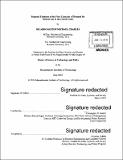| dc.contributor.advisor | Christopher R. Knittel. | en_US |
| dc.contributor.author | Charles, Ricardo Keston Michael | en_US |
| dc.contributor.other | Technology and Policy Program. | en_US |
| dc.coverage.spatial | n-us--- | en_US |
| dc.date.accessioned | 2016-10-14T15:54:42Z | |
| dc.date.available | 2016-10-14T15:54:42Z | |
| dc.date.copyright | 2016 | en_US |
| dc.date.issued | 2016 | en_US |
| dc.identifier.uri | http://hdl.handle.net/1721.1/104830 | |
| dc.description | Thesis: S.M. in Technology and Policy, Massachusetts Institute of Technology, School of Engineering, Institute for Data, Systems, and Society, Technology and Policy Program, 2016. | en_US |
| dc.description | Cataloged from PDF version of thesis. | en_US |
| dc.description | Includes bibliographical references (pages 87-92). | en_US |
| dc.description.abstract | A misalignment of incentives in the gas pipeline construction process has caused growth of gasfired generation to outpace investment in new pipelines in New England. Limited gas capacity to the region has resulted in power reliability issues, particularly during severe winter weather when gas demand is high. The majority of proposed solutions have focused on increasing gas supply. However, demand response in the natural gas retail market is a potential alternative answer. To quantify the benefits of gas demand response regional and state level price elasticities of demand for natural gas must be known. In this thesis, the price elasticity of demand for natural gas in the U.S. was estimated for the period 2001 to 2014 at the national, regional and state levels for the residential, commercial and industrial sectors. Differences in demand estimates were observed when performed at the different aggregate data levels and sectors. However, not all the regional and state estimates obtained for each sector showed statistically significant differences from each other or the national level. The short-run regional estimates for New England were used in a simple demonstration of gas demand response to show how they could have been used to mitigate the effects of the 2014 cold snap on electricity generation. Prices were optimized such that they reduced gas demand from retail markets by the amount of fuel that generators were short while minimizing the total deadweight loss. | en_US |
| dc.description.statementofresponsibility | by Ricardo Keston Michael Charles. | en_US |
| dc.format.extent | 92 pages | en_US |
| dc.language.iso | eng | en_US |
| dc.publisher | Massachusetts Institute of Technology | en_US |
| dc.rights | M.I.T. theses are protected by copyright. They may be viewed from this source for any purpose, but reproduction or distribution in any format is prohibited without written permission. See provided URL for inquiries about permission. | en_US |
| dc.rights.uri | http://dspace.mit.edu/handle/1721.1/7582 | en_US |
| dc.subject | Institute for Data, Systems, and Society. | en_US |
| dc.subject | Engineering Systems Division. | en_US |
| dc.subject | Technology and Policy Program. | en_US |
| dc.title | Regional estimates of the price elasticity of demand for natural gas in the United States | en_US |
| dc.type | Thesis | en_US |
| dc.description.degree | S.M. in Technology and Policy | en_US |
| dc.contributor.department | Massachusetts Institute of Technology. Engineering Systems Division | |
| dc.contributor.department | Massachusetts Institute of Technology. Institute for Data, Systems, and Society | |
| dc.contributor.department | Technology and Policy Program | |
| dc.identifier.oclc | 959240122 | en_US |
